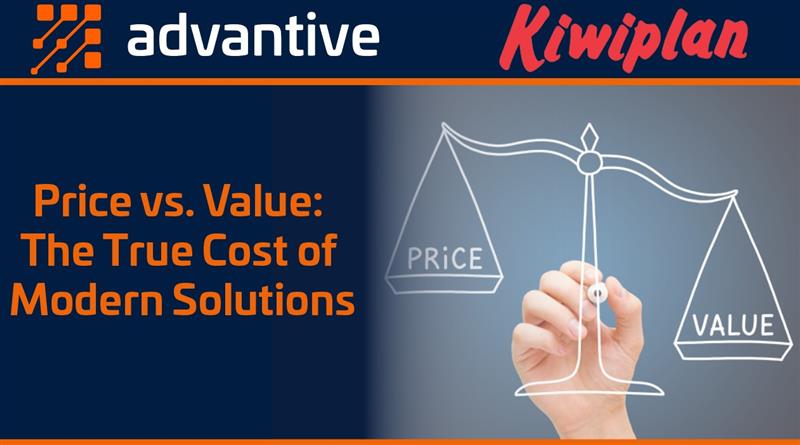
By Scott Anderson
Sticker shock!
We’ve all experienced it – that feeling when you see the price of an item and it is higher (sometimes, quite a bit higher) than expected.
But, when it comes to technology, the price doesn’t tell the whole story. Quite often, you have to look deeper to discover the true value of a product or solution. That’s when you see just how much this “expensive” technology can actually benefit your organization.
Better together
The concept isn’t new. All-in-one. Bundling. However it is phrased, the idea is to include multiple technologies, services, or functionalities into one product. In this way, the product helps the purchaser save time and money.
In the software world, new solutions are introduced to help organizations consolidate operations, data, disparate systems, and much more. So, it is logical that a product or solution enhanced with many useful features or integration would carry a higher price than a standard solution.
Despite the seemingly higher initial cost, these feature-filled offerings are becoming the top choice of organizations looking for greater benefit from their purchase. Although these solutions might cost more upfront, the integration capabilities they offer provide enormous value in the long run. And software providers have discovered that providing a solution that helps their customers become more efficient, improve performance, and save money is a smart business plan.
After all, as entrepreneur Richard Branson said: “In a competitive market, it’s not always the lowest price that wins but the best value.”
The benefits of integration
In today’s fast-paced manufacturing landscape, software integration plays a pivotal role in streamlining operations and driving efficiency. Many manufacturers still rely on fragmented systems — separate tools for inventory, scheduling, production, and logistics — that don’t communicate effectively with one another. This disjointed approach leads to serious consequences: visibility gaps, limited automation capabilities, and frequent integration breakdowns. Without a unified system, teams often resort to manual data transfers and processes, which are prone to human error, time-consuming, and ultimately lead to scheduling issues, production backlogs, and unnecessary waste.
The impact of these silos extends beyond daily operations. Disconnected systems make it difficult to gain a real-time view of production performance or make data-driven decisions quickly. When integration is lacking, any process improvement effort is hampered by slow information flow and duplicated efforts. For manufacturers striving to compete in an increasingly digital environment, these inefficiencies can be costly. That’s why a staggering 83% of organizations now identify product integrations as one of their top strategic priorities.
Integration is no longer a nice-to-have — it’s a core requirement when choosing a software provider. In fact, 39% of organizations consider integration capabilities the most important factor during the software selection process. Seamlessly integrated systems empower manufacturers with end-to-end visibility, allowing for smarter scheduling, faster response to disruptions, and greater agility. Ultimately, strong software integration not only supports operational excellence but also enables manufacturers to scale, adapt, and innovate with confidence.
Made for packaging manufacturers
Packaging manufacturers are no exception to the need for integrated, automated, AI-driven solutions to stay competitive and efficient. When systems are siloed and reliant on manual processes, it opens the door to costly errors, production backlogs, excess waste, and missed deadlines—putting both profitability and customer satisfaction at risk.
With minimal to no human intervention, a fully integrated system provide complete end-to-end task & scheduling automation/
- Determine the Optimized Route: Utilize automation to determine the fastest and most cost-effective truck routes.
- Align Timing and Scheduling: Align truck routes with machine production schedules to ensure on-time deliveries without delays.
- Integrate Planning and Scheduling Systems: Ensure the most efficient use of resources (labor and machines). Make sure the best mix of machines are scheduled for each job.
- Optimize Labor Scheduling: Automate shift assignments to ensure the right number of workers are assigned to tasks at peak production times – eliminating downtime due to lack of staffing.
- Provide Dynamic, Automated Adjustments: Use AI to automatically react to machine breakdowns, absenteeism, or sudden demand changes.
- Automate Ordering: Based on predicted demand and production schedules. Automatically place inventory orders, if needed, as soon as a job is scheduled.
- Gain Real-time Visibility: Enterprise-wide visibility allows you to strategically manage your operations from one central location.
Invest in a strategic packaging solution
“Quality is remembered long after price is forgotten.”
That was one of the guiding principles of Aldo Gucci, former chairman of the famous designer brand that bears his family name.
Software providers should also operate with this same rule in mind. That’s because, after the initial purchase, customers will likely only remember how the software performed and the benefits it (hopefully) provided.
For packaging manufacturers, that means implementing a fully integrated system that can provide efficiencies across the business. That’s the real value of any software purchase.